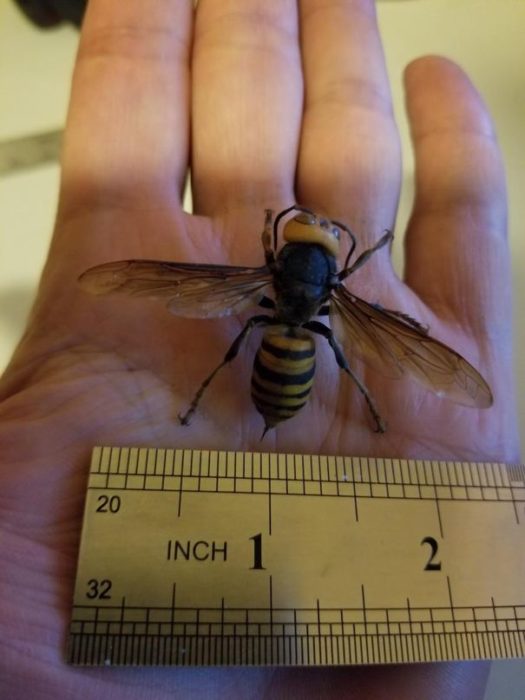Oct 26 2020
Murder Hornets Found and Destroyed
 Invasive species can be a serious problem. They may lack predators to keep their populations in check, and some may be predators themselves, preying on species that cannot defend against them. Eventually a new equilibrium will be reached, but in the meantime this can be destabilizing and in the long term will reduce diversity. The “invasive species of the year” for 2020 has to be so-called “murder hornets”.
Invasive species can be a serious problem. They may lack predators to keep their populations in check, and some may be predators themselves, preying on species that cannot defend against them. Eventually a new equilibrium will be reached, but in the meantime this can be destabilizing and in the long term will reduce diversity. The “invasive species of the year” for 2020 has to be so-called “murder hornets”.
The proper name for this insect is the Asian giant hornet (Vespa mandarinia), and as the name implies it is native to temperate and tropical regions of Asia. It is the largest hornet species on Earth. As insects go, they are huge – “The hornet has a body length of 45 millimetres (1 3⁄4 inches), a wingspan around 75 mm (3 in), and a stinger 6 mm (1⁄4 in) long, which injects a large amount of potent venom.” Their nickname, “murder hornet”, derives from their behavior. They prey upon other insects, mainly honey bees, but also mantises and even other hornets. If they enter a honey bee nest, even a few hornets can wipe out the entire nest in several hours. They typically kill by decapitating the bees with their large mandibles. The bees defenses are all but useless – their stingers too small to penetrate the hornet’s armor.
They are not much of a direct threat to humans. Only about 40 people per year are killed in Asia from giant hornet stings. They are not generally aggressive, but will attack if they are threatened. They can sting multiple times, and their stinger is long enough to penetrate typical beekeeping suits. Their venom is known for producing incredible pain, and can cause some local tissue damage. So even if you don’t die, being stung will not be a pleasant experience. Their real threat to humans is indirect – from the threat they represent to our pollinators.
You can imagine, then, the worry when earlier this year several individual Asian giant hornets were found on the West coast. If they were not lone stowaways, and were in fact part of a nest, that could spell disaster for the honey bee industry. Honey bees are already under significant stress from infections, climate change, and pesticides. Colony collapse disorder is still a problem, one which is actively being researched. Pollinators are critical to our food infrastructure, and so adding a new threat to a major pollinator could be disastrous.
But hopefully we had a window to prevent the giant hornets from establishing themselves in North America. Once they do, they will likely spread widely, maybe even globally. So scientists starting looking for any possible giant hornet nests. You obviously can’t just go tree-to-tree looking for them, so their plan was to find and trap a live giant hornet, then attach a tracking device to it and follow it back to its nest. And that’s exactly what they did. They found a live hornet, and they tied a tracking device to it with dental floss. The creature eventually flew home to its nest, which was in Washington state near the Canadian border. They then used a vacuum tube to suck all the giant hornets out of the nest, destroying it. And then they cut down the tree for good measure, to make sure they did not leave behind any other nests.
This was not the first nest destroyed in North America. Earlier this year a group of beekeepers from British Columbia, Canada, found and destroyed a nest.
It’s likely these are not the only nests in North America. We can hope, but we should not count on it. Also, new giant hornets can be introduced from Asia, riding along on ships or possible even jets (if they can get inside). So we need to keep up our vigilance. The scientists how have a proven method of tracking individual hornets back to their nest, which is a good thing. Perhaps we might find other ways of detecting and then tracking the hornets. Any sign of them needs to be removed immediately. Once they are fully established it can become impossible to eradicate them.
Invasive species are definitely one downside of a global economy. We move stuff all around the world, and inevitably this will include the unintended introduction of organisms. We should not just accept this as unavoidable, however, and it is worth the investment to put into place strict rules to minimize such introduction. Many nations do have regulations, and there are also regional and international agreements. If you have ever traveled to New Zealand you will see how rigorous such regulations can get. But we definitely need to do more on the international level. While every country does need to protect itself to some degree, this is definitely a global problem that needs global solutions.
It is a lot easier to prevent the introduction of an invasive species than try to deal with it once it has happened.






